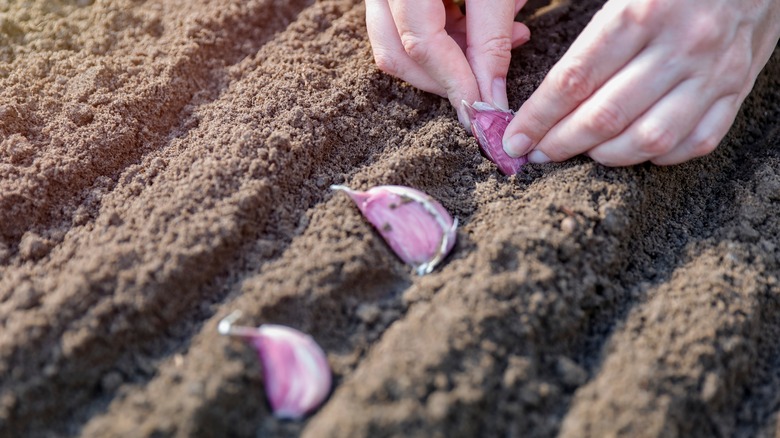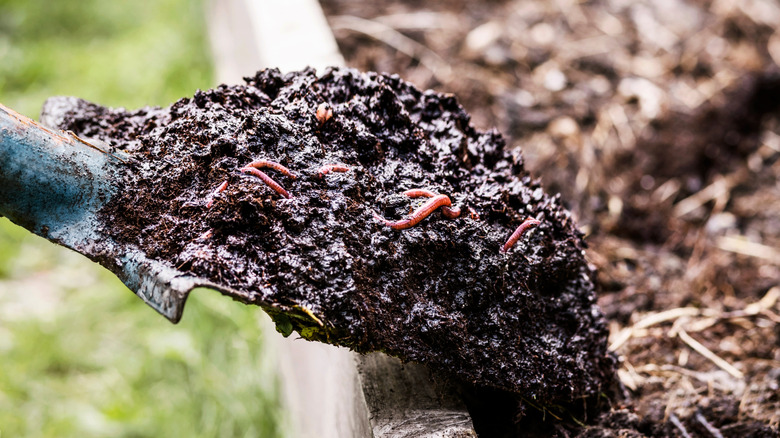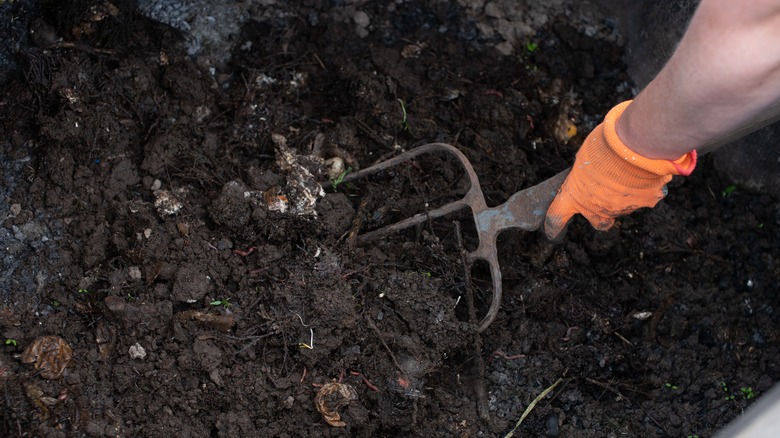How To Optimize Your Soil To Grow Bigger And Better Garlic
Whether this is your first time growing garlic or you're a seasoned home-grown produce pro, you've probably come across plenty of advice on why you shouldn't grow your own grocery store garlic or the difference between hardneck and softneck garlic. But one of the most important and easiest to overlook factors for a successful garlic harvest is your soil.
While the aromatic veggie can technically grow in a variety of soil types, you won't get the plump, high-quality bulbs you want unless you create the optimal conditions for those bulbs to develop. For example, if you make sure to wait until you know your garlic is ready to harvest to pull them up, and they look small or misshapen, your soil is probably to blame. For the best bulb development, you need a nutrient-rich, well-draining soil that's loose enough to allow garlic bulbs to grow freely.
In dry soil, bulbs won't grow as large. But in wet, poorly-draining soil, they're prone to bulb rot. Meanwhile, in heavy clay or rocky soil, bulbs can become misshapen as they struggle to grow in the denser conditions. Fortunately, no matter what kind of soil you're starting with, you can usually add amendments or work it in a way that creates the right conditions for a better garlic harvest. The key is figuring out exactly what your soil is missing so you can make the right fixes.
Soil amendments for a better garlic harvest
To create the perfect moist but well-drained soil high in the nutrients garlic needs to thrive, you need organic matter. Whether you have sandy soil that dries out too quickly or heavy clay that doesn't drain fast enough, tilling in some compost before planting can help improve the drainage while also adding nutrient-rich material for the garlic to feed on as it grows. To do this, spread a 1-inch layer of compost on top of the bed before planting. Then, till it into the top 6 inches of soil so that you have a 6-inch layer of crumbly, nutrient-rich soil for garlic bulbs to grow in.
While some gardeners choose to fertilize garlic to encourage bigger bulbs, the amount and type of fertilizer needed really depends on your soil. Garlic is considered a moderate to heavy feeder, especially of nitrogen and phosphorus. But it's important to get your soil tested before applying any fertilizer because going overboard can cause problems of its own. For example, adding too much nitrogen in spring can delay bulbing while excess phosphorous can build up in the soil and end up polluting local waterways. If a soil test does show that you're low in a particular nutrient but not in others, look for a formula that has a higher ratio of that missing nutrient and lower levels of the ones that are already plentiful in your soil to avoid messing up the nutrient balance.
Soil cultivation tips to grow bigger, better garlic
In addition to tweaking the nutrient profile and texture of your soil with amendments, you might also need to use a few other gardening tricks to get the conditions just right. Before planting, till the soil generously, especially if you have heavy clay. Your goal is to create a large bed of loose soil that the garlic can grow without hitting any compacted or stony patches.
Because garlic grows best in consistently moist soil, add a layer of mulch after planting. A 2- to 4-inch layer of straw, leaves, or another lightweight organic mulch will help retain moisture so the soil doesn't dry out as quickly between waterings. If you're in a cold climate, push the mulch aside for a few weeks in spring to allow the soil to warm up before putting it back in place to continue providing moisture and temperature regulation.
Lastly, no matter what else you do to your soil, weeding regularly so that weeds never get too big is key. Garlic doesn't compete well with other plants. It also has a shallow root system so allowing weeds to become too well-established before pulling them can end up disturbing those roots. This is one of the many reasons why fall is the perfect season to start planting garlic. In addition to exposing the bulbs to a cold period so they grow larger, it allows each clove to establish its roots when competition from weeds is less intense. Mulching will also help you keep weeds at bay.


